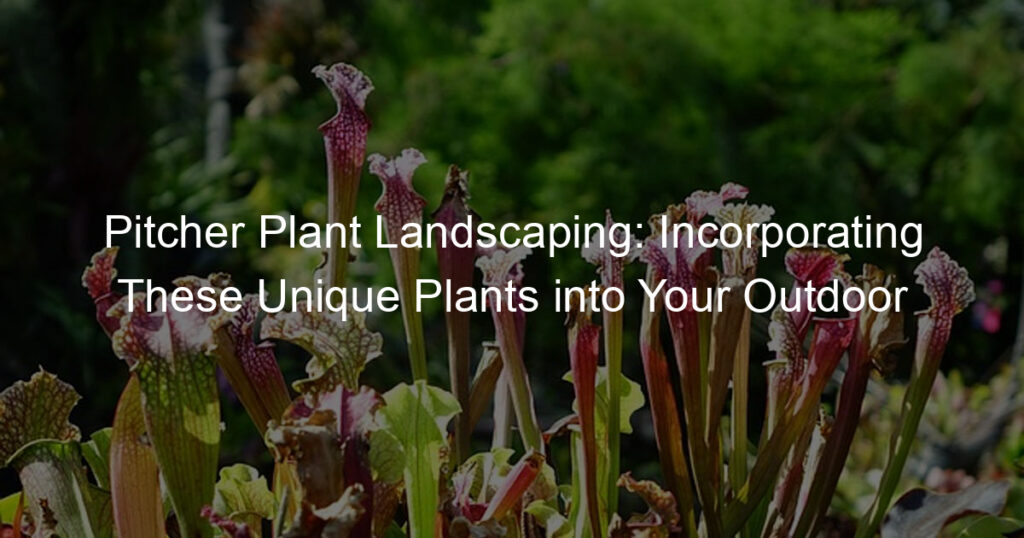Are you looking for a unique way to spruce up your outdoor space? Have you ever considered the amazing pitcher plant for landscaping purposes? These remarkable and hardy plants are a great addition to any garden due to their resilience, lush foliage, and amazing colors. Whether you’re looking to create an exotic landscape or just add some color and texture to your yard, pitcher plants could be the perfect solution!
Can pitcher plants grow in full sun?
Most gardeners would be surprised to learn that pitcher plants can actually thrive when grown in full sun. Although they require plenty of moisture, pitcher plants can get more than enough from direct sunlight and regular watering.
Native to wetlands and boggy areas, the ability of these carnivorous plants to thrive in the full sun shows their remarkable adaptability, making them a great choice for any ambitious gardener looking to add something special to their outdoor space.
What soil do pitcher plants need?
Who knew that something as seemingly simple as choosing soil for your pitcher plant could be so complicated? Pitcher plants, which are native to North America and grow in a variety of wet habitats, need well-draining acidic soil.
Peat moss is usually the go-to choice as it provides moisture without becoming soggy and holds onto acidic levels quite nicely. As long as the pH is between four and seven, you’ll be in good shape when providing soil for your pitcher plant!
To make sure you give your plant the environment it needs to thrive, mix peat moss with perlite or sand at a two-to-one ratio and add some pine bark or sphagnum for even more moisture retention. This way your beloved pitcher plant can live happily ever after!
How do I protect my pitcher plant from pests?
Protecting your pitcher plant from pests can be a daunting task, but it’s a necessary one to have a healthy and strong plant. The best way to protect your pitcher plant is to know what kinds of pests you’re up against.
Common insects like aphids, mealy bugs, and scale can all wreak havoc on your plant. Once you know the culprits, you should take preventive measures such as not over-watering or fertilizing them, making sure there’s good air circulation around the plants, and keeping an eye out for any dead or discolored leaves that could signal an issue.
If needed, use an insecticidal soap spray and make sure to spray underneath the leaves so the pests don’t hide in crevices. To combat diseases like bacterial rot or powdery mildew, remove any infected areas represented by dark spots or moldy patches from your plant with a sterile pair of scissors and dispose of them away from other plants. With these tools in place, your pitcher plant will be healthy and thriving!
Can I grow pitcher plants in a pond?
Growing pitcher plants in a pond can be an exciting and unique way to liven up your water feature or garden. They don’t require much maintenance and are also quite low-light tolerant.
Though they are carnivorous, they can live in the same ecosystem as other aquatic plants – though they may feast on tadpoles or mites that exist there.
Additionally, having pitcher plants increases insect biodiversity as many different kinds of insects will flock to them! Therefore, having pitcher plants in a pond is worth considering if you want to add more interest and diversity to your water feature.
What are the best pitcher plants for landscaping?
Pitcher plants are unique, carnivorous plants that provide an interesting and nature-inspired addition to any landscape. There are numerous pitcher plant varieties available for landscaping, many of which require minimal maintenance.
Of those, the Purple Pitcher Plant and the Cobra Plant are two popular choices with stunningly beautiful flowers and intricate foliage. The Purple Pitcher Plant has purple-tinged leaves in a cup shape that make it easy to spot in the garden. It produces vibrant pink or white flowers and grows best in partial sunlight.
Likewise, the Cobra Plant is a lovely low-maintenance pitcher plant that features bright yellow flowers and coats of burgundy-purple on its leaves. It prefers shaded areas with moist soil conditions but can still endure periods of complete drought if necessary. Both pitcher plants offer a captivating appearance to spruce up any outdoor space!
How do I incorporate pitcher plants into my garden design?
Incorporating pitcher plants into your garden can be a great way to add beauty and texture to your outdoor space. The unusual shape, color, and size of the leaves will instantly draw attention at any time of year.
When choosing what kind of pitcher plant to add, consider if you want a terrarium or an outdoor setup. You can opt for a single plant or combine different species for even more visual interest.
Placing these exotic beauties near a water element or in moist, well-drained soil where their roots can soak up plenty of moisture means they’ll stay healthy and provide years of enjoyment. Whether you’re looking to get creative with your landscaping or just want a unique addition to your current layout, incorporating pitcher plants is the way to go!
Conclusion
Now that you know all about pitcher plants, it is time to get creative and give your outdoor space a unique touch with these interesting little oddities! Combining various pitcher plant types along with complementary lush green grassy areas and colorful flowers can make for a captivating garden that is sure to draw the attention of admirers. When creating your dream garden, don’t be afraid to think outside the box and explore the possibilities.








